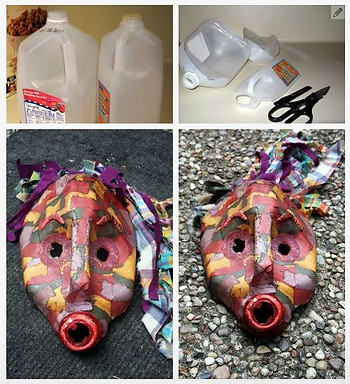
“Masks are powerful symbols for the dual nature of human experience and the bicentric character of the universe.
The cosmos is personified, transmuted to our own configuration and, in identification with it, we are somehow given the ability or strength to master forces beyond ourselves..
Between life and death, day and night, stands the human face as a gateway to two worlds, conscious and unconscious.”
-Ray Zone, 1981
Ritual Mask (South Pacific), Friedlaender Collection
Photo: Temple Anthropology Museum
MASKS:
MATERIALITY AND MEANING
MASKS AND MATERIALITY

What is Materiality?
Materiality looks at the experiences of material life. Materiality takes into account both the composition and construction of the object, and the object's interaction with the human experience.
Balinese Performer (Indonesia)
Photo: Wikimedia Commons
In terms of composition, masks are generally constructed from a variety of materials found in a community's surrounding environment. Many cultures use metals, clay, wood, or other hearty plant-based materials such as gourds to create the overall base structure of the mask. The design and structure of the mask depends greatly on the way it is intended to be used.

Kaxinawá Ritual Mask (Rio Curanja, Peru), Kensinger Collection
Photo: Temple Anthropology Museum

The design and ornamentation of the mask depends greatly on the symbolic significance the object is to portray. For example, the mask to the right has been decorated with a kene kuin design that represents Kaxinawá identity. The design is seen as a crucial element of beauty among individuals and things (Lagrou, 2004).
Masks can be painted with natural tannins or ochre, and decorated with items such as animal/human hair, horns, teeth, shell, or feathers.
The materials used above and to the right to construct these Kaxinawá Ritual Masks have symbolic significance in many ways. For example, gourds are typically cut in half and each side represents either a male (seen here) or female spirit. The person wearing the mask takes on the role of the spirit it represents.

Kaxinawá Ritual Mask (Rio Curanja, Peru), Kensinger Collection
3-D Scanning by Temple Anthropology Museum
Artisans in many cultures still use materials with traditional or historical significance. However, some artists today incorporate more “exotic” materials such as commercial paints or Styrofoam due to limited availability and governmental regulations on accessing traditional materials (Jackinsky-Horrell, 2009).
Mask Artisan (India)
Photo: Amitabha Gupta, Wikimedia Commons
What materials would you choose from your surrounding environment to create a mask?
Do these materials have symbolic significance to you?
The answer to these questions lies within the concept of meaning.

MASKS AND MEANING
“To make a mask is an excursion to that primordial zone where personal identity meets
[that with] which it is constituted. This is truly a search for 'roots' in the deepest sense,
a quest into the field of life's vitality”
(Larsen and Larsen, 1981).
Anthropological approaches to masks typically consider the meaning and symbolism of masks, and the social functions of masking rituals. Masks can be used to convey meaning in many different ways, and act as icons and indexes of cultural identities, beliefs, and practices (Pollock, 1995).
.jpg)
Mask Artisan (Myanmar)
Photo: Xinhua/U Aung, Xinhuanet News
For example, check out these mask makers and performers in Cirebon, Indonesia.
How do these masks function in terms of meaning, and what are they communicating to their audiences?
CULTURAL USES OF MASKS
Take a closer look at how masks, through their material construction and usage in society, convey meaning and function in cultures around the world.
Oral Histories
Portrait masks are used by the Tsimshian Nation to educate their community about their culture and ancestral history. Check out this interview from the National Museum of the Native American with a Tsimshian community member discussing the significance of portrait masks in Tsimshian culture.
Celebrations / Commemorations
Masks play an important role in the Dama ritual performance held by the Dogon community in Mali after a bountiful harvest. This mask festival celebrates community ancestors, and is a rite of passage for young boys into manhood. Check out this clip from National Geographic about the Dogon Dama.
Ceremonial / Religious
Masks have been used in Mexico for centuries for ceremonial and religious purposes. Masks were used in funerary ceremonies as early as the Aztecs, and over time were incorporated into religious rites and rituals. Even today masks play an important ceremonial and religious role during the annual Carnival festival. Check out this video from the International Wood Culture Society to learn more about Masks and Mexico.
Medicinal / Therapeutic
Masks have been used as a tool in preventative and curative medicinal rituals among the Sinhalese in Sri Lanka. Disease devil masks were used to cure members of the community of ailments such as deafness (Bailey, 2006). Check out a public adaptation of the disease devil mask performance from WEVA TV.
Additional resources
Readings
Bailey, Mark S. 2006. “Sri Lankan Sanni Masks: An Ancient Classification of Disease.” BMJ 333: 23-30.
Eves, Richard. 2009. “Speaking for itself: Art, Meaning, and Power in New Ireland, Papua New Guinea.” The Australian Journal of Anthropology 20(2).
Jackinsky-Horrell, Nadia. 2009. “Contemporary Alutiiq Masks and Meaning.” AlterNative 5(1): 73-87.
Lagrou, Elsje Maria. 2004. "Huni Kuin (Kaxinawá)." Povos Indigenas Brasil.org. Povos Indigenas Brasil, 2004. Accessed April 2020. https://pib.socioambiental.org/en/Povo:Huni_Kuin_(Kaxinaw%C3%A1).
Laughlin, Charles D and Judi Young-Laughlin. 1988. “How Masks Work, or Masks Work How?” Journal of Ritual Studies 2(1): 59-86.
Massanari, Ronald L. 2000. “Seeing (through) Masks: An Exploration of Masks and Mask Making.” Visual Anthropology 13: 279-294.
Pollock, Donald. 1995. “Masks and the Semiotics of Identity.” Journal of the Royal Anthropological Institute 1(3).
Museum Collections
Stop by the Temple Anthropology Laboratory and Museum to check out masks from following collections:
Kensinger Collection
Friedlaender Collection
Miller Collection



